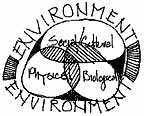

“Man is that uniquely conscious creature who can perceive and express. He must become the steward of the biosphere. To do this he must design with nature.” (McHarg, 1969)

Graphic Overlay Sketch In 1968 the landscape architect Ian McHarg published the book “Design With Nature”. It has become a standard for land planners and managers because it considers the earth’s natural and human systems from the point of view of the landscape architect. Never before had the complexities of the relationship of land use elements been combined graphically to conclude proposed alternative locations of land and water activities.
McHarg’s process was to create a spatially correct, graphic model (of the existing conditions, opportunities, and constraints), test alternative solutions, and determine what was thought to be the best possible option. The case examples McHarg provided were arguments for the collection of detailed information specifically pertinent to the needs of his clients.
He developed a process that began with a knowledge of the client’s needs and targeted the collection information toward that need. Mc Harg’s book is a guide and still a handbook for suggesting, and directing the collection of composite map information.
Relevant Applications
The environmental books teach us the earth is a compound/complex arrangement of physical, biological, and cultural components with an infinite range of potential “so-called” social and appropriate solutions. Many point out that prime agricultural land and best forest land is vanishing at an alarming rate in this country.
Others are quick to point out not all land is suitable for agriculture, and not all land is appropriate for housing development. The question is how do communities determine the “best use” or the appropriate “range of use possibilities” for any particular portion of land. Whether good or bad…, all land and the human use to which it is put is ever-changing.
Pattern Interpretation
Activities and resources have been historically identified by their distinct patterns. Human activities tend to be geometric patterns, while natural resource patterns appear organic. Gaining experience with natural system surface patterns and understanding the pattern contrast of human activities will pay huge educational dividends to those that spend the time investment.
Pattern cognition begins with a realization that there is potential for: “The characteristics of mountains are often reflected in the soils”, or “Atoms behave at the molecular level predictably at the scale of the universe”. Natural systems and natural processes obey logical patterns that are predictable. But, one must be sensitive to inconsistencies such as:
1) Not all patterns reflect natural systems.
2) Some activities are not easily recognizable.
3) Patterns can yield incorrect assumptions.
4) Without pattern cognition, GIS is only chaos.
5) Some patterns are only distractions.
Understanding the distributions, relationships, and organizations of natural systems is integral in gaining the capability to “input” the data of GIS, but not critical to understanding GIS application. Achieving competence will require one to cultivate collateral skills and techniques that, while not essential to learning GIS, are critical to GIS proficiency related to environmental issues.
Developing and using “your best judgment.”
With any given location within a community, there are positive qualities and negative qualities. The positive qualities are the opportunities (for building houses, creating wetlands, building roads, etc.). The negative qualities are the constraints (like too many rocks to farm the land, to wet to grow pine trees for lumber, too steep for a safe road, etc).
We all want our local areas and neighborhoods to enjoy the “best” possible land (and water) uses that, (during construction and years after), will have the least environmental impact and seriously attempt to maintain (or enhance) the character to the community.
Before recommending a particular land use, as local citizens we should all ask several fundamental questions:
Are we developing the collective conditions that are best for this landscape? Before any construction ask: can I technically do what is proposed for this portion of land? More often we could ask: “should I change this land from its current use?”
Typical questions that could be answered
using the Graphic Overlay Method of GIS:
-
- Will this soil support the proposed building foundation?
- Does this property flood.., will it damage my building?
- Will agricultural crops grow well here?
- Will my road be too steep for trucks?
- Will the landfill contaminate the groundwater?
- Is this a dangerous area for landslides?
- Is this the best location for my new orchard?
- What and where are wetlands?
- What and where are agricultural lands?
- What agricultural lands are most/least productive?
- What and where are forest lands?
- What forest lands are most/least productive?
- Where will the new highway be best located?
- Where will the new airport be best located?
- Where is the best wildlife habitat?
- Where are the best locations for a new industry?
- Where is the best location for the new vacation resort?